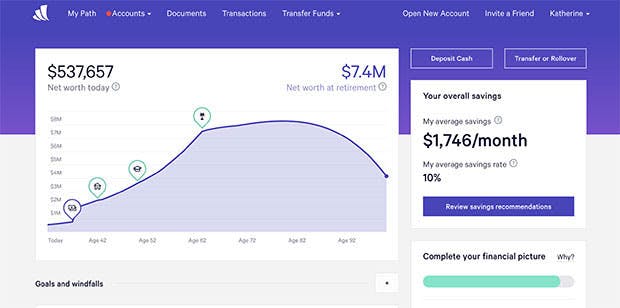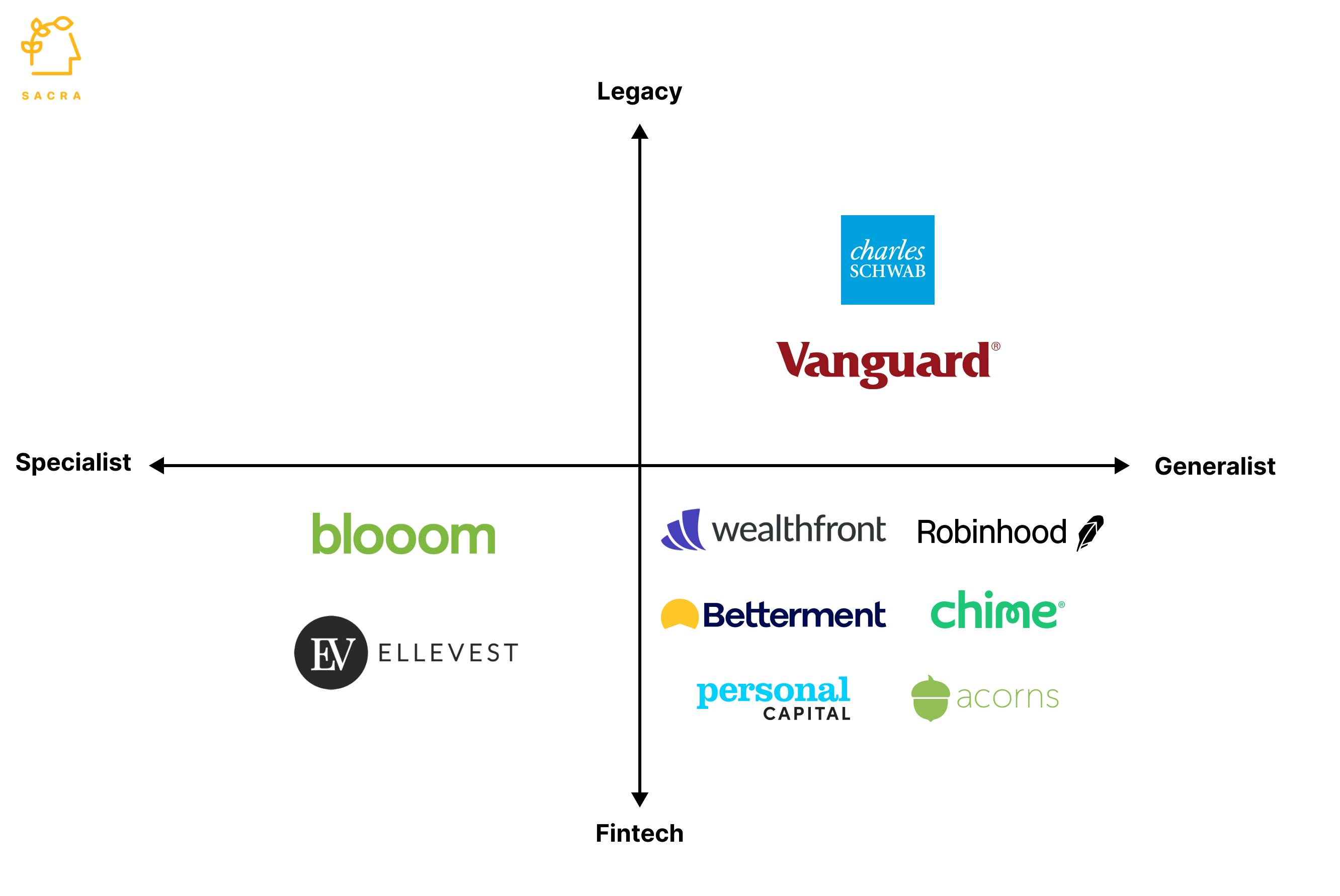
Revenue
$183.50M
2023
Valuation
$1.40B
2023
Growth Rate (y/y)
117%
2023
Funding
$268.07M
2022
Revenue
Sacra estimates that Wealthfront grew revenue to $184M in 2023, up 117% from $91M in 2022. The primary cause of Wealthfront's sudden revenue acceleration, after growing just 16% year-over-year in 2022, was increased AUM via deposits both to their core robo-advisor product and to their Wealthfront Cash high-yield checking accouts.
As interest rates rose from the spring of 2022 through the summer of 2023, the effect was to significantly increase the amounts that neobanks like Wealthfront and Betterment could earn on their deposits, creating a way for them to acquire customers by passing some of those earnings on.
Wealthfront grew AUM from $31B at the end of 2022 to $55B at the end of 2023, while at the same time benefitting from the improved unit economics of their cash accounts vs. their traditional robo-advisor accounts. Cash accounts allow Wealthfront to earn about 0.40% per dollar of AUM vs. 0.25% per dollar of AUM on their robo-advisor product.
Valuation
Wealthfront is valued at $1.4 billion as of 2023. The company has raised $274.2 million across 8 funding rounds. Key investors include UBS, which provided a $69.7 million convertible note in September 2022, along with Index Ventures and Social Capital, who participated in multiple funding rounds including Series D through Series G. Earlier investors include Benchmark Capital and Ribbit Capital.
Product

In 2008, Wealthfront launched as one of the first robo-advisors, giving consumers access to a delightfully-designed web app for managing their finances via diversified investment portfolios for a simple fee of 0.25% of AUM annually. For the first $10,000 a customer deposited, they waived that fee, making it essentially free to sign up for a broad range of younger milennials.
In comparison to financial advisors that charge 1% of AUM or more, Wealthfront positioned itself as the cheaper option, simultaneously bringing down their costs on the back-end by investing user deposits in low-fee exchange traded funds (ETFs).
Wealthfront was able to bring its costs below those of traditional financial advisors while still extracting value by virtue of their well-designed app, which brought together all of a user's money and spending and investments in one app with bank integrations from Plaid.
As Wealthfront grew, it expanded its offerings to include features like direct indexing, which allowed clients to own individual securities in their portfolios for greater tax efficiency, and bond portfolios. The company also introduced banking services, such as high-yield cash accounts and lines of credit, aiming to become a one-stop-shop for its clients' financial needs.
Today, Wealthfront manages over $60B in assets for more than 800,000 clients.
Competition

The US investment management market is becoming saturated with fintechs and legacy players offering their customers low-cost, robo-advisor investment services. The number of robo-advisor account holders grew to 3.5M in 2021, 2X from 2018, but their growth is expected to slow down to 10.4% YoY to reach 5.2M by 2025.
Wealthfront competes with traditional players like Charles Schwab and Vanguard, which started rival robo-advisor services after the launch of Wealthfront. By leveraging their vast network and bringing their fees below those of Wealthfront, they have become the two largest robo-advisors by AUM.
Apart from other robo-advisors such as Betterment and Personal Capital, Wealthfront also competes with fintechs such as Acorns (financial wellness), Chime (neobank), and Robinhood (DIY investment). There are also specialist robo-advisors such as Ellevest (robo-advisor for women) and Bloom (IRA and 401k) that cater to specific verticals.
TAM Expansion
The growth playbook for Wealthfront, at its core, means offering more financial products to scale AUM, monetize its customers in new ways, and keep them around for longer.
After introducing robo-advising, giving consumers access to a bucket of different ETFs through their app, Wealthfront layered on additional features like high-APY cash accounts, automated bond portfolios, and Robinhood-like direct stock picking.
They've also launched lending, allowing customers to borrow up to 30% of their AUM with Wealthfront at rates of 7.65% to 8.90%, receiving their funds in 1 business day. Expanding into lending has become a core part of the fintech/neobank playbook. They've also started offering 529 college savings plans and IRA retirement plans.
Apart from investment products, Wealthfront could consider launching its own credit cards and insurance, either directly or acting as a distributor for others.
The key is to build features that help them maintain their customers for longer, with churn a key risk factor for robo-advisors like Wealthfront that can see customers leave for other, more fully-featured platforms. By offering products like college investing and retirement that create a longer-term relationship with Wealthfront beyond a checking account or a high-yield savings account, Wealthfront can increase its chances of retaining those relationships as their customers get older, earn more money, and contribute to rising AUM per customer.
Risks
Lower interest rates
Wealthfront is one of the neobanks that benefitted greatly in 2023 from the rise in interest rates driving up the yields that they could both collect from deposits and offer to their users. Wealthfront's 117% revenue growth in 2023 was a testament to this—but the problem is that interest rates won't stay high forever. By the time they come back down, Wealthfront will either have to have new lines of business that can pick up the slack, or they will have to convince their new users to stick around and invest and spend with them in the long-term.
Lack of differentiation
Wealthfront acquired users rapidly in the early years by offering a low cost investment service to DIY investors who found traditional investment management firms too expensive. However, now with traditional investment firms, neobanks, and other robo-advisor firms offering nearly identical products at similar management fees, there isn’t much to differentiate one robo-advisor app from another. As the product becomes more commoditized, Wealthfront may struggle to acquire customers for its core investment service business.
Funding Rounds
|
|
|||||||||
|
|||||||||
|
|
|||||||||
|
|||||||||
|
|
|||||||||
|
|||||||||
|
|
|||||||||
|
|||||||||
|
|
|||||||||
|
|||||||||
|
|
|||||||||
|
|||||||||
|
|
|||||||||
|
|||||||||
|
|
|||||||||
|
|||||||||
| View the source Certificate of Incorporation copy. |
News
DISCLAIMERS
This report is for information purposes only and is not to be used or considered as an offer or the solicitation of an offer to sell or to buy or subscribe for securities or other financial instruments. Nothing in this report constitutes investment, legal, accounting or tax advice or a representation that any investment or strategy is suitable or appropriate to your individual circumstances or otherwise constitutes a personal trade recommendation to you.
This research report has been prepared solely by Sacra and should not be considered a product of any person or entity that makes such report available, if any.
Information and opinions presented in the sections of the report were obtained or derived from sources Sacra believes are reliable, but Sacra makes no representation as to their accuracy or completeness. Past performance should not be taken as an indication or guarantee of future performance, and no representation or warranty, express or implied, is made regarding future performance. Information, opinions and estimates contained in this report reflect a determination at its original date of publication by Sacra and are subject to change without notice.
Sacra accepts no liability for loss arising from the use of the material presented in this report, except that this exclusion of liability does not apply to the extent that liability arises under specific statutes or regulations applicable to Sacra. Sacra may have issued, and may in the future issue, other reports that are inconsistent with, and reach different conclusions from, the information presented in this report. Those reports reflect different assumptions, views and analytical methods of the analysts who prepared them and Sacra is under no obligation to ensure that such other reports are brought to the attention of any recipient of this report.
All rights reserved. All material presented in this report, unless specifically indicated otherwise is under copyright to Sacra. Sacra reserves any and all intellectual property rights in the report. All trademarks, service marks and logos used in this report are trademarks or service marks or registered trademarks or service marks of Sacra. Any modification, copying, displaying, distributing, transmitting, publishing, licensing, creating derivative works from, or selling any report is strictly prohibited. None of the material, nor its content, nor any copy of it, may be altered in any way, transmitted to, copied or distributed to any other party, without the prior express written permission of Sacra. Any unauthorized duplication, redistribution or disclosure of this report will result in prosecution.